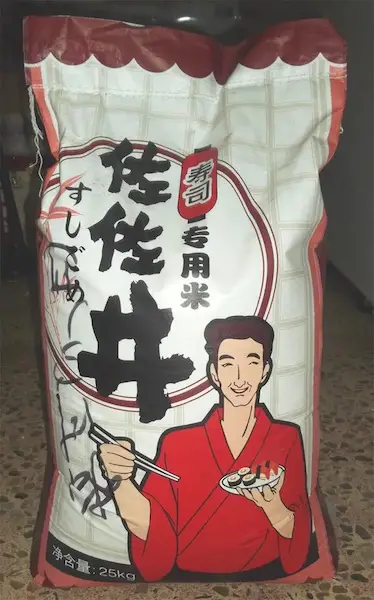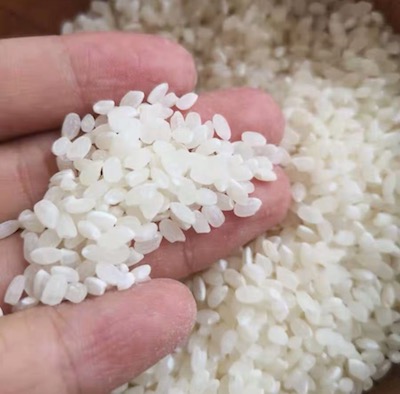We are reader supported. When you purchase through links on our site, we may earn an affiliate commission. Also, as an Amazon affiliate, we earn from qualifying purchases.

Sushi rice is an under-valued but important component of sushi, without which you cannot imagine this Japanese delicacy. Among the various things that make sushi rice so special is its sticky texture and slightly sweet flavor that complements the other ingredients.
Many people ask me ‘is sushi rice sticky rice?’ and the answer is No, sushi rice surely has a certain amount of stickiness which is essential, but it is different from the sticky rice or glutinous rice found mainly in Southeast and East Asia. The biggest difference between the two is that sushi rice contains both amylose and amylopectin, but sticky rice only comprises of amylopectin (amylase may be nil or negligible).
Sushi rice is made from Japanese short-grain rice (see my reviews), while the main cultivars of sticky rice include indica, japonica, and tropical japonica strains. Read on to find out other differences between both.
Difference Between Sushi Rice And Sticky Rice
Many people think that sushi rice and sticky rice are the same or interchangeable as both exhibit sticky texture not found in other varieties of rice. The type of Japanese rice used for making sushi may be short-grain or long-grain variety, however, the sushi rice found in the US is mainly the short-grain rice.
If you visit an Asian grocery store, you can find packets labeled as ‘sushi rice’ but in Japan, no one calls it sushi rice. It is considered as the plain rice that is eaten with seasonal vegetables and also used for making sushi. The Japanese never refer to it as sushi rice until it is seasoned with vinegar.

So, the term ‘sushi rice’ appears more like a marketing or advertising strategy to let people know that this rice is used in making the delicacy. Sushi rice has a sticky texture, which is further enhanced with vinegar, salt, and sugar. It is this ‘stickiness’ that helps the ingredients stays together in different shapes when making a nigiri or sushi roll.
Many people do not know there’s a special type of ‘sticky rice’ which is different and calling sushi rice sticky rice may create confusion. Also known as sweet rice for its characteristic sweetness, the sticky rice is mainly grown in Southeast and East Asian countries. The grains are opaque, unlike the Japanese short grains that are translucent.
Sticky rice contains low to no amylose content and the texture becomes extremely sticky to touch once cooked. It is often called glutinous rice because it sticks to your hands like glue, not in the context of containing gluten. Other types of grains contain both amylose and amylopectin. The stickiness of cooked rice may be high or low depending on the proportion between the two.
For example, the long-grain variety has a higher percentage of amylase (19-23%), which means you get a pot of nice fluffy grains that don’t stick together. Short grain (used in making sushi) has a considerably lower amylase content (12-19%) and sticky rice has a maximum of 1% amylase.
Types Of Food That Uses Short Grain Rice (Sushi Rice)
Known as ‘uruchimai’ in Japanese, this variety comes from the short-grain cultivar of Japonica rice. You can easily identify the variety by looking at the grains that appear short and plump. They are capable of retaining more moisture and are stickier than other varieties of rice.
Short grain rice has been around and used as a staple in Japanese cuisine for thousands of years. Although westerners mostly recognize it as sushi rice, it is eaten as the staple plain rice in Japan. It is also used in making ichiru sansei, which is a traditional meal in Japan.
Cooked short-grain rice is an important element in bento boxes and it may often be prepared with seasonal vegetables, meat, or seafood. The Japanese rice may also be fermented to create alcoholic drinks such as sochu, sake, and rice vinegar.
The two most prominent varieties of short-grain rice used for sushi are – Koshihikari and Akitakomachi Rice. Koshihikari Rice, often known as Koshi Rice is the most dominant variety in Japan. The grains are firm and they have a sweet aroma and sticky texture. Besides being used as sushi, the rice is also used for spicy entrée and desserts like pudding.
Akitakomachi Rice with its sweet aroma and nutty texture is the second most popular type of rice in Japan. When properly cooked, the grains may become moist, firm, and slightly sticky. It may be topped with a spicy curry or used for making different rice-based desserts.
Other common cultivars of short-grain rice are Yumepirika Rice, Oborozuki Rice, Sasanishiki Rice, and Yamada Nishiki rice. Both Oborozuki and Yumepirikia varieties can be found in the Hokkaido region. Sasanishiki rice is known for maintaining its flavor, whether hot or cold; and Yamada Nishiki is the type of rice used for making Japanese rice wine.
Tips For Preparing Sushi Rice
The short-grain rice is typically used in almost every meal and is prepared using the modern rice cooker like this in most households in Japan. The benefit of cooking in a cooker is that it takes the guesswork out of the process. You just add the measured amount of water and soaked rice and you are done.
An important pre-cooking tip is to rinse and soak the short-grain rice for 30 minutes to 2 hours, depending on the season. The uncooked rice should be rinsed thoroughly to remove any excess amount of Amylopectin Starch over the surface.
After the rice is thoroughly rinsed, soak it before cooking. The soaking time is usually adjusted as per the outside temperature so you have shorter soaking time in summer and longer in winter. It will also depend upon the quality of grains.
The older Japanese short-grain rice requires more water, so for every 4 cups of rice, you would need 5 cups of water. The new or fresher short-grain rice variety needs water in 1:1 ratio. If you go to the grocery store to buy rice for making sushi at home, I would recommend that you ask for the newest or first crop of the season, also known as shinmai variety in Japanese.
Purchase and Storage
In the grocery stores, you will typically find the Japanese short-grain rice variety available as white rice. They may be available as brown rice with the rice bran intact in some places, but most likely you will find the white rice in prepackaged containers.
If you visit a Japanese or Asian market, you can expect to find Japanese Short Grain Rice available in bulk quantities. Before buying a bulk bin, always check the expiry date because the rice can go bad if stored for a long time.
When buying short-grain rice in bulk, keep an eye for any sign of moisture. If you buy the brown variety with rice bran attached, they are more susceptible to damage. Exposure to air and moisture can turn the rice bran oil in the rice bran rancid or sour.
You must also be careful about not buying rice with too many broken grains or your dish will turn into a mess. If you try cooking whole grains and broken grains together, they will not cook uniformly. By the time the whole grains are cooked, the broken ones will become mushy and spoil the overall texture.
When it comes to storage, the dry and unopened packet of white rice will stay good indefinitely at room temperature. It may also be frozen or kept inside the refrigerator. Once opened, it is important to transfer the rice to an airtight container and protect it from moisture and pets. Brown rice has a shorter shelf life due to the oil content.
Types Of Foods Prepared With Sticky Rice

While the sticky rice is used widely across Asia, it is mostly seen in Chinese cuisine in different types of dishes such as desserts, dumplings, stuffing in duck, etc. While most of the recipes involve steaming or boiling the rice, it can also be fried in the risotto-style.
In Chinese cooking, they use long-grain sticky rice for the savory dishes and short-grain sticky rice for sweet dishes or desserts. This is because the long-grain variety is firmer and less sticky than the short grain counterpart.
Some of the common foods prepared with sticky rice are stuffed lotus root, pearl meatballs, steamed lotus leaf wraps, mango sticky rice, and peanut sticky rice. Sticky rice is also a staple food in Laos and it is also used in preparing numerous Thai foods that are popular around the globe.
Interestingly, sticky rice may come in different colors and the high starch content gives the grains a chalk-like appearance. For example hulled sticky rice is white, but the unhulled variety may be purple or even black. The colored varieties are more expensive because they are rare and mostly used in preparing fine desserts.
Tips for Preparing Sticky Rice
Whether you should soak sticky rice or not before cooking depends upon the type of dish you are making. You will see that soaking sticky rice makes it very soft and sticky. So, I would suggest that you follow the instructions mentioned in the recipe when making a dish for the first time.
Sticky rice requires comparatively less water to cook than regular rice. As a result, traditionally the sticky rice is steamed instead of boiling. You may use a bamboo steamer, steamer basket, or wok for steaming rice. Alternatively, you may cook sticky rice in a cooker to save time and for every 2 cups of rice, add 2.5 cups of water.
Purchase and Storage
If you want restaurant-like results when making sticky rice, look for the bags that are labeled as ‘glutinous rice’, ‘sweet rice’, or ‘long-grain sticky rice’. Those who can’t find it in the supermarket or an Asian grocery store can look for it online.
Some people may use white rice or short-grain rice as a substitute for sticky rice, but let me warn you that this will not yield the desired results. You can’t achieve the kind of stickiness needed for traditional dishes. Other names for sticky rice is mocha rice, pearl rice, and waxy rice.
The sealed bag of sticky rice can last for long but if you have opened the bag, transfer the content into an airtight container and keep inside the freezer for up to 2 months. Cooked sticky rice can be stored in the refrigerator for one day or two, not beyond that.
Related Questions
Does sticky rice contain gluten?
No, even though it is called glutinous due to its glue-like texture, it does not contain any gluten, hence it can be safely consumed by people on a celiac diet.
Is sushi rice gluten-free?
The plain short grain rice or white rice does not contain any gluten but when it is seasoned with vinegar or other sauces to make sushi, it is no more gluten-free. I have created an article that talks about gluten content in sushi in detail, check it here – does sushi have gluten.
Can I use sticky rice in the place of sushi rice?
I would say ‘No’ unless you want to create a mess out of your sushi. Both sushi rice and sticky rice have distinct personalities and they are best suited for different cuisines. It’s better not to substitute them for each other.
See Also: Is Sushi Seafood


